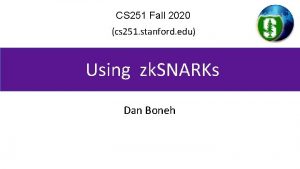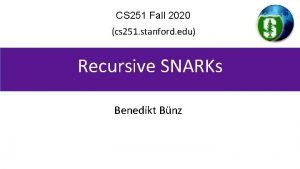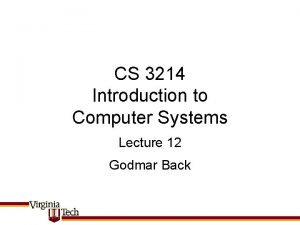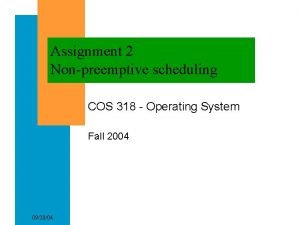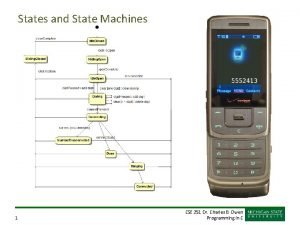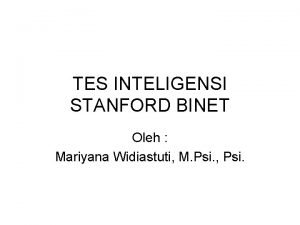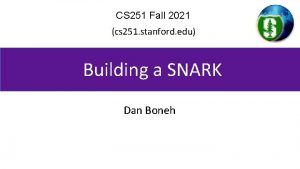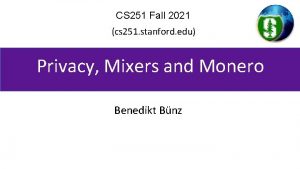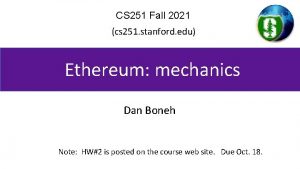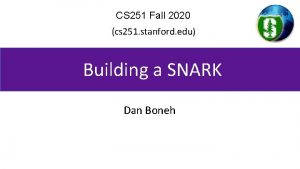CS 251 Fall 2021 cs 251 stanford edu



![Tx structure (non-coinbase) input[0] input[1] input[2] inputs output[0] output[1] (segwit) witnesses (4 bytes) input: Tx structure (non-coinbase) input[0] input[1] input[2] inputs output[0] output[1] (segwit) witnesses (4 bytes) input:](https://slidetodoc.com/presentation_image_h2/1096ed212d9975835f9a333ba03270d7/image-4.jpg)

































- Slides: 37

CS 251 Fall 2021 (cs 251. stanford. edu) Bitcoin Scripts and Wallets Dan Boneh Note: HW#1 is posted on the course web site. Due Oct. 4.

Recap: the Bitcoin blockchain genesis block H version prev time bits nonce Tx root (4 bytes) H (32 bytes) (4 bytes) (32 bytes) 80 bytes coinbase Tx BH 3 BH 2 BH 1 coinbase Tx prev H prev … Tx root

Tx sequence View the blockchain as a sequence of Tx (append-only) … coinbase Tx Tx cannot be erased: mistaken Tx ⇒ locked or lost of funds
![Tx structure noncoinbase input0 input1 input2 inputs output0 output1 segwit witnesses 4 bytes input Tx structure (non-coinbase) input[0] input[1] input[2] inputs output[0] output[1] (segwit) witnesses (4 bytes) input:](https://slidetodoc.com/presentation_image_h2/1096ed212d9975835f9a333ba03270d7/image-4.jpg)
Tx structure (non-coinbase) input[0] input[1] input[2] inputs output[0] output[1] (segwit) witnesses (4 bytes) input: Tx. ID = H(Tx) Tx. ID out-index Script. Sig seq 32 byte hash value Script. PK 8 bytes 4 byte index program ignore (excluding witnesses) output: (part of input) program locktime earliest block # that can include Tx #BTC = value/108

Example null locktime Tx 1: (funding Tx) 2 input value Script. PK UTXO 1 5 value Script. PK 0 UTXO 2 UTXO: unspent Tx output Tx 2: (spending Tx) Tx. ID 1 identifies a UTXO Script. Sig output UTXO 3 UTXO 4 0

Example Tx 1: (funding Tx) 2 input Script. PK UTXO 1 UTXO: unspent Tx output Tx 2: (spending Tx) Tx. ID 1 identifies a UTXO Script. Sig ☓ 5 Script. PK null locktime 0 UTXO 2 output UTXO 3 UTXO 4 0

Validating Tx 2 program from funding Tx: under what conditions can UTXO be spent Miners check (for each input): 1. The program Script. Sig | Script. PK returns true 2. Tx. ID | index is in the current UTXO set program from spending Tx: proof that conditions are met 3. sum input values ≥ sum output values After Tx 2 is posted, miners remove UTXO 2 from UTXO set

Transaction types: (1) P 2 PKH pay to public key hash Alice want to pay Bob 5 BTC: • step 1: Bob generates sig key pair (pk. B, sk. B) �Gen() • step 2: Bob computes his Bitcoin address as addr. B �H(pk. B) • step 3: Bob sends addr. B to Alice • step 4: Alice posts Tx: Point to Alice’s UTXO Script. PKB: input 7 BTC UTXOB for Bob 5 Script. PKB UTXOA for Alice (change) 2 Script. PKA DUP HASH 256 <addr. B> EQVERIFY CHECKSIG 0

Transaction types: (1) P 2 PKH pay to public key hash “input” contains Script. Sig that authorizes spending Alice’s UTXO • example: Script. Sig contains Alice’s signature on Tx � miners cannot change Script. PKB (will invalidate Alice’s signature) Point to Alice’s UTXO Script. PKB: input 7 BTC UTXOB for Bob 5 Script. PKB UTXOA for Alice (change) 2 Script. PKA DUP HASH 256 <addr. B> EQVERIFY CHECKSIG 0

Transaction types: (1) P 2 PKH Later, when Bob wants to spend his UTXO: Txspend: Tx. ID 0 points to UTXOB Script. Sig. B <sig> <pk. B> output create a Txspend output 0 (authorizes spending UTXOB) <sig> = Sign(sk. B, Tx) where Tx = (Txspend excluding all Script. Sigs) (SIGHASH_ALL) Miners validate that Script. Sig. B | Script. PKB returns true

Transaction types: (2) P 2 SH: pay to script hash (pre Seg. Wit in 2017) Payer specifies a redeem script (instead of just pkhash) Usage: (1) Bob publishes hash(redeem script) �Bitcoint addr. (2) Alice sends funds to that address in funding Tx (3) Bob can spend UTXO if he can satisfy the script Script. PK in UTXO: HASH 160 <H(redeem script)> EQUAL Script. Sig to spend: <sig 1> <sig 2> … <sign> <redeem script> payer can specify complex conditions for when UTXO can be spent

P 2 SH Miner verifies: (1) <Script. Sig> Script. PK = true �spending Tx gave correct script (2) Script. Sig = true �script is satisfied

Example P 2 SH: multisig Goal: spending a UTXO requires t-out-of-n signatures Redeem script for 2 -out-of-3: (chosen by payer) <2> <PK 1> <PK 2> <PK 3> <3> CHECKMULTISIG threshold hash gives P 2 SH address Script. Sig to spend: (by payee) <0> <sig 1> <sig 3> <redeem script> (in the clear)

Abstractly … Multisig address: addr = H(PK 1, PK 2, PK 3, 2 -of-3) Tx 1: (funding Tx) Tx 2: (spending Tx) input 7 BTC 5 addr UTXOB for Bob 2 Script. PKA 0 UTXOA for Alice (change) input: UTXO, sig 1, sig 3, PK 1, PK 2, PK 3, 2 -of-3 output 0

Example Bitcoin scripts

Protecting assets with a co-signatory Alice stores her funds in UTXOs for addr = 2 -of-2(PKA, PKS) PKA Alice spending Tx PKS is this Alice custody server yep, it’s me post Tx with <sig. A> <sig. S> on Tx ⇒ theft of Alice’s SKA does not compromise BTC

Escrow service Alice wants to buy a backpack for 0. 1�from merchant Bob Goal: Alice only pays after backpack arrives, but can’t not pay addr = 2 -of-3(PKA, PKB, PKJ) post payment of 0. 11� to addr (UTXOA) Alice PKA want backpack for 0. 1� once see Tx on chain mail backpack arrives send <sig. A> on Tx: UTXOA�(PKB: 0. 1, PKA: 0. 01) Bob Judge PKB PKJ redeem using <sig. A> <sig. B> on Tx

Escrow service: a dispute (1) Backpack never arrives: (Bob at fault) Alice gets her funds back with help of Judge and a Tx: ( UTXOA �PKA , sig. A, sig. Judge ) [2 -out-of-3] (2) Alice never sends sig. A: (Alice at fault) Bob gets paid with help of Judge as a Tx: ( UTXOA �PKB , sig. B, sig. Judge ) [2 -out-of-3] (3) Both are at fault: Judge publishes <sig. Judge> on Tx: ( UTXOA �PKA: 0. 05, PKB: 0. 05, PKJ: 0. 01 ) Now either Alice or Bob can execute this Tx.

Cross Chain Atomic Swap Alice has 5 BTC, Bob has 2 LTC (Lite. Coin). They want to swap. Want a sequence of Tx on the Bitcoin and Litecoin chains s. t. : • either success: Alice has 2 LTC and Bob has 5 BTX, • or failure: no funds move. Swap cannot get stuck halfway. Goal: design a sequence of Tx to do this. solution: programming proj #1 ex 4.

Managing crypto assets: Wallets

Managing secret keys Users can have many PK/SK: • one per Bitcoin address, Ethereum address, … Wallets: • Generates PK/SK, and stores SK, • Post and verify Tx, • Show balances

Managing lots of secret keys Types of wallets: • cloud (e. g. , Coinbase): cloud holds secret keys … like a bank. • laptop/phone: Electrum, Meta. Mask, … client stores secret keys • hardware: Trezor, Ledger, … • paper: print all sk on paper • brain: memorize sk (bad idea) • Hybrid: non-custodial cloud wallet (using threshold signatures) Not your keys, not your coins … but lose key ⇒ lose funds

Simplified Payment Verification (SPV) How does a client wallet display Alice’s current balances? • Laptop/phone wallet needs to verify an incoming payment • Goal: do so w/o downloading entire blockchain (366 GB) SPV: block header Tx root (1) download all block headers (56 MB) (2) Tx download: • wallet �server: list of my wallet addrs (Bloom filter) • server �wallet: Tx involving addresses + Merkle proof to block header.

Simplified Payment Verification (SPV) Problems: (1) Security: are BH the ones on the blockchain? Can server omit Tx? • Electrum: download block headers from ten random servers, optionally, also from a trusted full node. List of servers: electrum. org/#community (2) Privacy: remote server can test if an addr belongs to wallet We will see better light client designs later in the course (e. g. Celo)

Hardware wallet: Ledger, Trezor, … End user can have lots of secret keys. How to store them ? ? ? Hardware wallet (e. g. , Ledger Nano X) - connects to laptop or phone wallet using Bluetooth or USB - manages many secret keys - Bolos OS: each coin type is an app on top of OS - PIN to unlock HW (up to 48 digits) - screen and buttons to verify and confirm Tx

Hardware wallet: backup • ECDSA public key

On Ledger When initializing ledger: • user asked to write down the 24 words • each word encodes 11 bits (24 × 11 = 268 bits) • list of 2048 words in different languages (BIP 39)

Example: English word list ⋮ save list of 24 words

Crypto Steel Careful with unused letters …

On Ledger When initializing ledger: • user asked to write down the 24 words • each word encodes 11 bits (24 × 11 = 268 bits) • list of 2048 words in different languages (BIP 39) Beware of “pre-initialized HW wallet” • 2018: funds transferred to wallet promptly stolen

How to securely check balances? •

Idea 2: (used in HD wallets) • kpub does not reveal sk 1, sk 2, … computed from kpub

Paper wallet (be careful when generating) Bitcoin address = base 58(hash(PK)) base 58 = a-z. A-Z 0 -9 without {0, O, l, 1} signing key (cleartext)

Managing crypto assets in the cloud How exchanges store assets

Hot/cold storage Coinbase: holds customer assets Design: 98% of assets (SK) are held in cold storage (98%) hot wallet (2%) SKhot 2% of assets customers

Problems Can’t prove ownership of assets in cold storage, without accessing cold storage: • To prove ownership (e. g. , in audit or in a proof of solvency) • To participate in proof-of-stake consensus Solutions: • Keep everything in hot wallet (e. g, Anchorage) • Proxy keys: keys that prove ownership of assets, but cannot spend assets

END OF LECTURE Next lecture: consensus
 Cs 251 stanford
Cs 251 stanford Cs251 stanford solutions
Cs251 stanford solutions Stanford cs 251
Stanford cs 251 Highwire stanford edu
Highwire stanford edu Cs 3214 fall 2021
Cs 3214 fall 2021 Ucla fall 2021
Ucla fall 2021 Cos 318 princeton
Cos 318 princeton Cos318 fall 2021
Cos318 fall 2021 Tgfoa fall conference 2021
Tgfoa fall conference 2021 Edu.sharif.edu
Edu.sharif.edu A vida tem tristezas mil hinário
A vida tem tristezas mil hinário Cs 251
Cs 251 Anupam saxena
Anupam saxena 15-251
15-251 251 del 2000
251 del 2000 15 251
15 251 15-251
15-251 Aae 251
Aae 251 Aecp program army
Aecp program army Edu.ro programe scolare 2020-2021
Edu.ro programe scolare 2020-2021 Advantages of micro teaching
Advantages of micro teaching Karel the robot learns java
Karel the robot learns java Stanford
Stanford Stanford modellen
Stanford modellen Sherlock stanford
Sherlock stanford Mark kasevich
Mark kasevich Susie phillips stanford cheerleader
Susie phillips stanford cheerleader Stanford 10 test
Stanford 10 test Subtes binet
Subtes binet Hussein al baya
Hussein al baya Stanford exploration project
Stanford exploration project Ann dohn stanford
Ann dohn stanford Cs321 stanford
Cs321 stanford Cs 148
Cs 148 Abhinav agarwal stanford
Abhinav agarwal stanford Diego ongaro stanford
Diego ongaro stanford Cs155
Cs155 Stanford prison experiment right to withdraw
Stanford prison experiment right to withdraw
